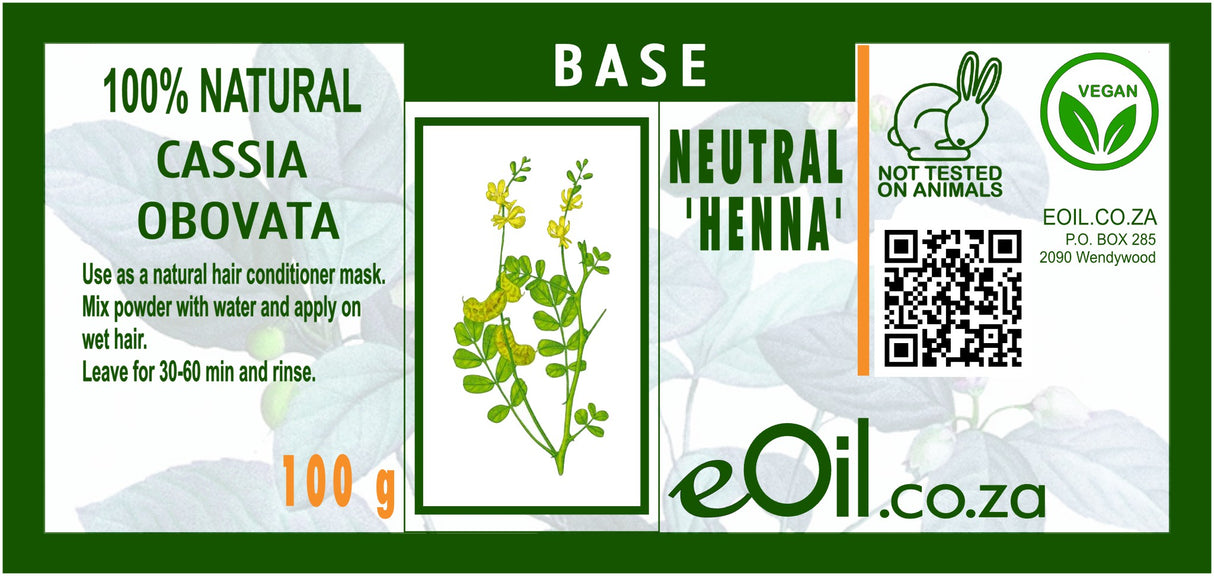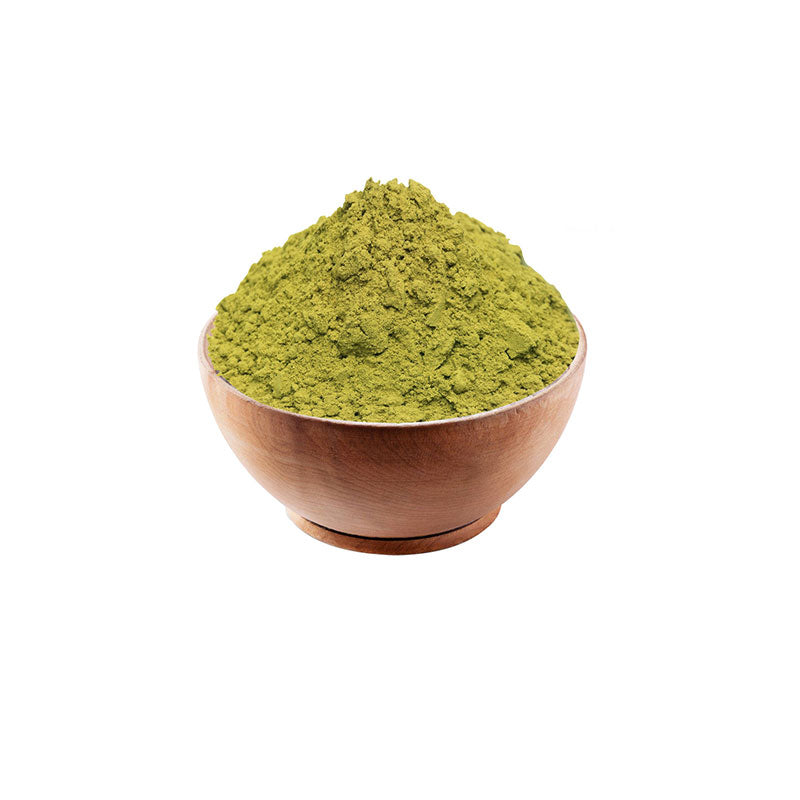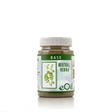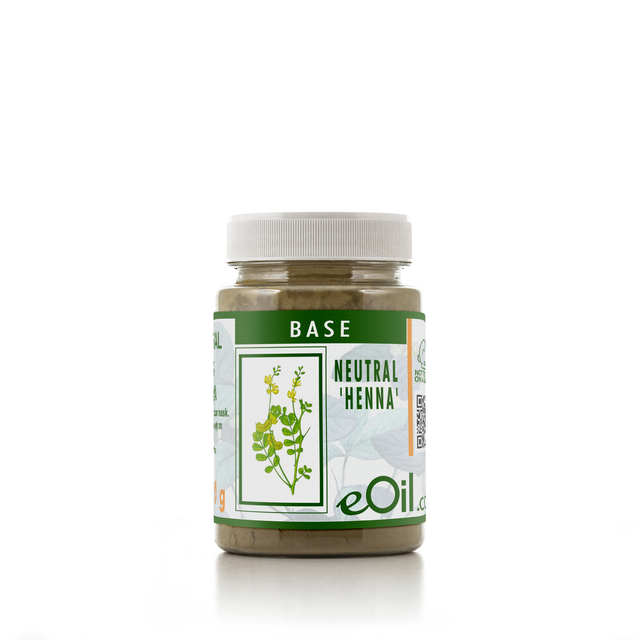Henna ground powder natural neutral base (Cassia obovata) 100 g
Henna ground powder natural neutral base (Cassia obovata) 100 g - 100 GR is backordered and will ship as soon as it is back in stock.
Description
Description
Natural Active Hair Conditioner, Revitalizer. To Manage And To Maintain Natural Curls And Coils. For Dry, Treatments-Damaged Hair, Dandruff. Skin Exfoliator.
- Sebum regulator: By regulating sebum secretion, neutral henna helps reduce the oily build up in hair, allowing for a longer period between shampoos
- Antiparasitic: Neutral henna is effective in controlling lice
- Does not noticeably colour dark hair
- Anti-dandruff: Neutral henna sanitizes the scalp, relieves irritation and helps fight dandruff.
- Exfoliating and purifying: Used in scrubbing, pure or with soap, neutral henna cassia eliminates dead skin cells and with its added antimicrobial natural properties, it purifies the skin.
- Hair fibre strengthening. Neutral henna cassia coats the hair from roots to tips in a protective layer. It makes each hair fibre stronger, easy to detangle while keeping their natural texture.
- Combat Hair loss
- Hair growth stimulator
IDENTIFICATION
NATURAL ACTIVE HAIR CONDITIONER, REVITALIZER. TO MANAGE AND TO MAINTAIN NATURAL CURLS AND COILS. FOR DRY, TREATMENTS-DAMAGED HAIR, DANDRUFF. SKIN EXFOLIATOR.
INCI name ; HENNA (Cassia obovata) GROUND POWDER NATURAL NEUTRAL BASE
CAS number 85085-71-8
SKU code ; BN-HEP-0100
PARTS USED ; leaf
ORIGIN ; South Africa
COMMON NAMES : cassia obovata
APPEARANCE : brown/pinkish to reddish/orange tint
QUALITY : 100 % pure and natural
STORAGE CONDITION ; Store in a cool dark place
REPORTED BENEFITS & PROPERTIES
Commonly called neutral henna, Cassia henna is not at all the same product as henna. Both are green powders produced from plant leaves and both are used in hair care. That is where the comparison stops because the powders originate from two completely different species of trees and have different active ingredients and properties.
Our 100% pure Neutral henna is a powder from the leaves of Cassia obovata. Its leaves contain a yellow resinous pigment (instead of the red resin dye in henna) and are used extensively for their deep conditioning and restorative qualities. Cassia neutral henna nourishes and revitalizes hair, restoring their strength and shine. Its antimicrobial properties also help fight dandruff and sanitize scalp, hair and skin.
Neutral henna Cassia does not stain and is not used as a hair colourant. It does not loosen or straighten curls and does not have a drying effect on your hair. It deeply conditions and leaves your hair feeling thicker, smoother, soft and shiny.
PROPERTIES
- Sebum regulator: By regulating sebum secretion, neutral henna helps reduce the oily build up in hair, allowing for a more longer period between shampoos
- Antiparasitic: Neutral henna is effective in controlling lice
- Does not noticeably colour dark hair
- Anti-dandruff: Neutral henna sanitizes the scalp, relieves irritation and helps fight dandruff.
- Exfoliating and purifying: Used in scrubbing, pure or with soap, neutral henna cassia eliminates dead skin cells and with its added antimicrobial natural properties, it purifies the skin.
- Hair fibre strengthening. Neutral henna cassia coats the hair from roots to tips in a protective layer. It makes each hair fibre stronger, easy to detangle while keeping their natural texture.
- Combat Hair loss
- Hair growth stimulator
INSTRUCTIONS OF USE HENNA BLACK - RED - NEUTRAL
To naturally colour/dye your hair, you can use:
- RED HENNA commonly referred to simply as “HENNA POWDER”: (Lawsonia inermis). Used alone, it dyes the support (textiles, skins, and hair) orange/red depending on the starting colour; semi-permanent natural dye, hair follicles conditioning and adds shine.
- INDIGO (Indigo tinctorei) also known as blue indigo, for darker tones and black colouring. Indigo used alone, will dye supports like textile, hair, and other material bluish, to dark blue.
For dying hair purposes Henna (red) and indigo are often used together, either combined in 1 paste (see percentages below), or in a 2- step application for black hair and grey hair coverage.
NOTE THAT: NEUTRAL HENNA (CASSIA): does not dye or colour. As the name says, it is a neutral powder, used to condition, nourish, and treat hair. Hair masks and deep conditioning.
METHOD:
BEFORE YOU START,
Know the total amount of powder you should use:
- Above ear length: 50-75 grams
- Shoulder length: 100-125 grams
- Bra strap length or mid-back: 150-175 grams
- Lower back (above hips): 200 to 225 grams
- Hip/Waist length: 250 to 300 grams.
EQUIPMENT NEEDED TO MIX PASTES AND APPLYING DYE:
- Bowls (porcelain, plastic, or glass- no metal): 1 or 2 depending on your recipe (1 step or 2)
- Gloves
- Spoons to mix (plastic, wood)
- Plastic to cover your bowl.
- Wear old clothes (that can be stained)
- Old Towels (that can be stained) or barber plastic cape.
- A plastic to cover your workstation/ floor from stains.
PREPARING/MIXING YOUR COLORING PASTE:
For Henna (red)- alone: dye in paste release time: from 2-3 hours to overnight (can be made the day before application); pause with dye on hair: 2-3 hours; dye is set after 2-3 days.
- In a bowl, add a quantity of powder according to your hair length.
- add liquids (water, teas…) little by little, and mix powder(s) until you reach a creamy/yogurt-like consistency. The paste should be thick enough to stick to your hair, but not too dry. When your paste has reached the wright consistency, add aloe vera gel and essential oils (tea tree…)
- Cover the bowl with a plastic and let the dye release. (For red henna, count a minimum 15-30 min, or even better, overnight)
Recommended Liquids/ingredients to mix with Henna RED powder.
Liquids can be added lukewarm to warm in temperature, never boiling:
Plain water,
Aloe vera juice,
Apple Cider Vinegar,
Hibiscus tea,
Green Tea or rooibos are any tea.
You can add a teaspoon of an oil that is beneficiary to hair or scalp (Castor, Amla…)
You can add a few drops of essential oils that are good for scalp/hair health (Tea tree, Niaouli, rosemary, Ylang-ylang…)
Please Note: do not use heavy liquids such as yoghurt, shea/cocoa butters, conditioners, etc…as they dilute the colour, and won’t yield the best colour coverage. Lemon juice is not recommended for hair colouring recipes as this would be much too harsh and drying to your hair.
For Indigo alone: dye in paste release time:10-15 min (must be applied as soon as dye is ready); pause with dye on hair: 3-4 hours; dye is set after 2-3 days.
- In a bowl, add a quantity of indigo powder according to your hair length.
- Add A PINCH OF SALT to WATER (NO teas with indigo)
- Add salted water little by little, mixing well until you reach a creamy/yogurt-like sticky consistency. The paste should be thick enough to stick to your hair, but not too dry. When your paste has reached the wright consistency, you can add a bit of aloe vera gel.
- Cover the bowl with a plastic and let the dye release. (Count 15-30 min, or until a dark purple shinny colour has developed at the surface. The rest of your paste under the surface will stay green. That is ok.)
- ATTENTION: Indigo paste is applied as soon as the dye has released. Do not wait, or worse, leave your paste overnight. The dye will not work. So, prepare your Indigo paste when you have the time set aside for application and pause.
APPLYING YOUR COLORING PASTE:
- WASH your hair with shampoo, so that all oily residues are completely gone. Do not apply any conditioner or conditioning treatment. DRY your hair.
- Apply some Vaseline or coconut oil on your forehead and hair line, anywhere you want to prevent staining of your skin (hair line, ears, nape of neck...)
- Wear old clothes and cover your neck and shoulder with an old towel to prevent staining.
- Wear gloves to protect your hands and nails.
- Brush your hair to remove all the tangles and part your hair in the centre.
- Apply your colouring paste, section by section, generously and thoroughly, from roots to tips, until your head is entirely covered, if this is your objective, or on the selected strand/sections of hair you want coloured.
- If your hair is long, twist each section covered with henna and clip it into a bun.
- Once your head/ section is saturated with paste, wrap your head with cling wrap or a shower cap, to help the dye develop while keeping the paste warm and moist.
- Allow between two to four hours for the dye to set. The longer you wait, the more vibrant the result. Do not allow the paste to set dry on your hair.
- Wash and rinse your hair thoroughly with plain warm water. You can use a conditioner cream to help remove stubborn paste but NO SHAMPOO. Rinse out the conditioner and towel dry your hair.
- Natural dyes take about 24 to 48 hours to set completely. Only then, feel free to shampoo and condition/treat.
PROPORTIONS OF HENNA (RED) AND INDIGO TO ACHIEVE THE COLOUR YOU WANT:
- In one bowl, prepare the henna (red) paste as directed (you can prepare it the day before, so the dye has time to release completely).
- Once the red henna paste is ready, and you are ready to apply your dye, mix your indigo paste in a separate bowl, as directed above (remember indigo paste doesn’t wait too long)
- Mix the henna and indigo together, following the ratios indicated below.
- Everyone has their own unique hair texture and hair type. Some people may find Henna and Indigo drying for their hair. That is why it is recommended that you add aloe vera (gel or powder) when mixing the dye paste(s). You can also deep condition (nourish and hydrate) using creams or appropriate oils, after your colour has settled (3-5 days).
- With trial and practice, you will be able to adjust your hair colouring recipe and frequency of treatments based on your specific needs and target.
- Use the recipe that works best for you and your hair.
Red/orange tones: use 100% red henna only.
Reddish brown: use 70% red henna and 30% indigo (3 parts henna to 1 part indigo). One-step colouring application. Can be mixed with hibiscus powder, beetroot juice, rooibos tea…
Brown tones: use Equal parts of henna and indigo (50/50-50% indigo and 50% red henna). One-step colouring application. Can be mixed with black coffee, a black tea…
Dark chocolate browntones: use 70% indigo and 30% henna (1 part henna to 3 parts indigo). One-step colouring application. Can be mixed with black coffee, black tea…
Black tones: Use the 2-step method: apply 100%, red henna first. Followed (immediately or within 72 hours) by indigo paste at 100%.
2 STEP METHOD FOR BLACK TONE:
1RST STEP:
Using red henna first, follow the directions to make of the henna paste and apply as directed. Leave red henna on your hair 3-4 hours. COMPLETELY rinse out the henna WITH PLAIN WATER. DRY your hair.
2ND STEP:
Following up right after, or the next day (within 3 days of the red henna dyeing), mix your INDIGO PASTE (indigo powder + water), wait 10-15 min for the dye to develop and apply to your hair immediately, section by sections. Wrap your head with plastic or an old shower cap. Leave on for 3-4 hours. Rince and wash your hair with plain water. Wait 2-3 day before washing with shampoo and applying other kind of conditioning treatments.
Resistant Hair and Greys Method: Should your hair or greys be resistant to colouring, you may need to re-apply indigo paste a second time (leave on for a shorter period of time, such as 1-2 hours). Repeat until you are satisfied with the effect.
FOR ALL HENNA HAIR COLOURING TREATMENTS, rinse out once the dyeing process is complete. Moisturize, dry and style as usual. Do not deep condition after colouring as it can remove some of the dye. We recommend you use a water-based leave in conditioner to moisturize your hair or a light hair oil such as our Jojoba Oil or Camellia Oil.
Note that henna-based dyes, being plant-based, sometimes will take more than 1 application to get best coverage (even 3-4 to really build up especially on stubborn grey and previously chemically dyed hair). Colour can be repeated every 4-6 weeks or root touch ups in between as needed.
MORE INFO:
Red Henna works like layers of paint, thoroughly coating the hair strand, rather than bleaching it. The end colour is a combination of both the red Henna colour and your hair’s base colour.
Red Henna only maintain or darken your natural hair colour (and even more so when combined with Indigo) . It cannot lighten or “bleach” them.
ABOUT Neutral Henna
Neutral Henna (alkaner) can be used to add shine and volume to hair without adding colour. Henna (Lawsonia Inermis) and Neutral Henna (alkaner) are not the same plant powders.
Neutral Henna is the common term for a different plant, the Cassia Obovata leaves powder. Neutral henna powder offers the same great conditioning benefits as the red Henna and can add shine and volume when applied to hair. A very good conditioning ingredient for all type of hair, Neutral Henna will however NOT colour your hair.
Some blonder hue or golden shine hints can somewhat be achieved on existing natural blond hair with Neutral henna (alkaner) by adding marigold flowers and chamomile tea when mixing the paste.
For visual aid, we have found the following YouTube links that may be of help. (Please note that we are including these links purely for help purposes. We have no affiliation or connections whatsoever with the authors, originators of these materials. Use or follow at your own discretion.
For accurate info or when in doubt, please consult a qualified haircare professional, who has knowledge and practice in using natural plant powder material.
https://www.youtube.com/watch?v=euMKcX3zg3s
https://hennasooq.com/blogs/frontpage/complete-guide-how-to-colour-your-hair-with-henna-and-indigo/
https://www.youtube.com/watch?v=4gtsfcIbxyA
CAUTION
Keep out of reach of children and pets.
As a general rule, always perform a skin patch test before using your essential oils for the first time.
WARNING: These properties, indications and methods of use are taken from reference works or websites in aromatherapy, hydrolatherapy and phytotherapy. They are found there regularly and for many confirmed by observations in scientific circles. However, this information is given for informational purposes, it cannot in any case constitute medical information, nor engage our responsibility. For any use for therapeutic purposes, consult a doctor.

Henna ground powder natural neutral base (Cassia obovata) 100 g - 100 GR is backordered and will ship as soon as it is back in stock.






